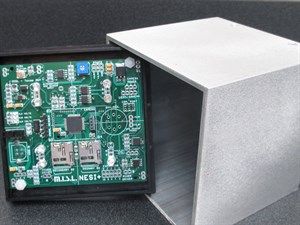 Two embedded intelligence systems designed and developed by undergraduate students in Texas A&M University’s Dwight Look College of Engineering were aboard a SpaceX Falcon 9 rocket headed to the International Space Station (ISS).
Two embedded intelligence systems designed and developed by undergraduate students in Texas A&M University’s Dwight Look College of Engineering were aboard a SpaceX Falcon 9 rocket headed to the International Space Station (ISS).
The Electronic Systems Engineering Technology (ESET) students developed a new control, monitoring, recording and reporting system called NESI+ (NanoRacks Embedded Systems Interface). The students have actively collaborated with NASA, the Center for Advancement of Science in Space (CASIS), NanoRacks, Airbus Defense, Space Systems Division and a number of public and private secondary schools across the country in their development effort.
The students originally designed and delivered the embedded microcontroller-based capability for a NASA-HUNCH Extreme Science teacher at Clear Springs High School in League City, Texas to aid her plant growth experiment that is currently scheduled to be flown on the ISS.
Based on analysis of competing technologies, the NESI design was chosen to support more than 16 high schools spanning three time zones during the 2013 academic year as part of the NASA Extreme Science program. At this point in the development, former ESET students, Mickie Byrd and Willis Twigge turned over the continued development and support of the NESI+ embedded system to current students Dakotah Karrer, Colton Schimank, Vince Rodriquez, William Nault and Hector Paz.
Karrer and Schimank are primarily involved in the support and enhancement of the embedded hardware and software. Rodriquez, Nault and Paz are mentoring three schools in the Denver area that are participating in Phase II of the CASIS National Design Challenge program. All of these student projects using the NESI+ hardware and software are scheduled to fly on the ISS. While these experiments are being developed or awaiting transfer to the ISS, the ESET students have been supporting the integration of the NESI+ technology into two experiments that are now running on the ISS
Dr. Josh Caldwell of the University of Central Florida developed the first of the two experiments called “NanoRocks” which uses the microgravity environment of the ISS to study very slow collisions within the particle chamber. Dr. Gary Stutte from Limerick Institute of Technology in Limerick, Ireland is conducting the second experiment “Symbiotic Nodulation in a Reduced Gravity Environment” or “Synerge3” that studies plant/microbe interactions in space. Both researchers are using the NESI+ embedded environment for their experiments. These researchers were able to send their experiments to the ISS via NanoRacks’ Commercial Space Act Agreement.
In addition to the direct support of researchers and others developing experiments for the ISS, the team of undergraduate students from Texas A&M is teaming with NanoRacks and its partner, Airbus Defense and Space Systems, to provide an active demonstration of the NESI+ capabilities. Both companies are using the demonstration system as part of their exhibit booth at space research and development conferences across the United States promoting the value of the NESI+ embedded monitoring, control, recording and reporting system among the research community.